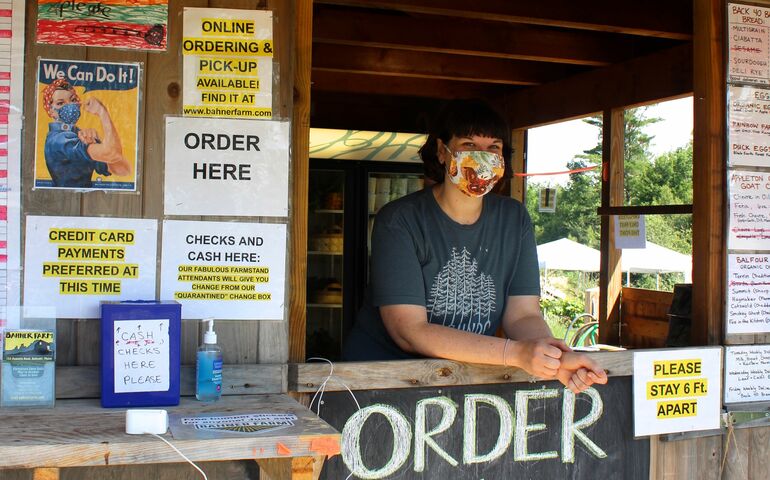Surveys show mixed results for Maine farmers during pandemic, more support needed
 Photo / Catie Joyce-Bulay
Over the past year, some farmers have adopted collaborative marketing, such as shared farm stands. Seen here is Britney Rhine, managing the Bahner Farms’ farmstand in the Waldo County town of Belmont.
Photo / Catie Joyce-Bulay
Over the past year, some farmers have adopted collaborative marketing, such as shared farm stands. Seen here is Britney Rhine, managing the Bahner Farms’ farmstand in the Waldo County town of Belmont.
While the pandemic is affecting many industries, the impact on farming may be unique.
A series of four surveys, all sponsored by the University of Maine Cooperative Extension and presented in a panel discussion last week, demonstrate some of the effects, including market shifts, a mix of revenue losses and gains, and the need for more support and infrastructure.
Instability
A three-part survey on how COVID-19 has affected farmers revealed both revenue gains and losses and significant changes in the way farmers market their products — changes that may be here to stay.
The survey was conducted from March to September last year in collaboration with the Maine Farmers Resource Network. At the start of the pandemic in March 2020, 26% of the 175 farmers surveyed reported losing $100-$1,000 in sales per week. That number remained similar in May (25% of 79 farmers).
While 15% reported losses of $1,000-$5,000 in March, the number fell to 10% in May. Although 50% of farmers reported no losses in March, since most were not yet marketing products for the season, in May that number dropped to nearly 22%.
A significant number of farmers who reported on their gross sales in September made less than last year, while 23% made more than last year and roughly 21% made the same amount.
Farmers noted that even if they did not experience less sales volume, their income was less stable due to increased production costs. Those were a result of packaging requirements to comply with COVID safety guidelines and new expenses related to online sales platforms, along with pandemic-related labor shortages.
Many farmers experienced the need to change their market channels. Online sales jumped to 41% of farmers, and 26% adopted more collaborative marketing, such as sharing farm stands, while 21% made the shift to direct marketing from wholesale and restaurant sales. Most farmers surveyed in September said they plan to keep the changes they made.
“I was amazed at how quickly producers were able to get their online sales platforms up and running, and how quickly the general public took to that,” said presenter Jason Lilley, UMaine sustainable agriculture professor in Cumberland County.
The greatest concerns for farmers throughout the survey included labor needs, pandemic-related stress and the drought.
Resilience
Another survey conducted this spring, led by the Maine Organic Farmers & Gardeners Association, reflected total sales for 2020 and predictions for the upcoming 2021 growing season. The survey focused on market access with a goal of finding strategies to build deeper resilience into the local food system, as farmers face continued market disruptions, such as those related to climate change.
In 2019 the 50 producers surveyed made a total of $3.5 million in gross sales, up to $3.8 million in 2020 and predicted to reach $4.2 million 2021. Most dramatic increases were seen for on-farm sales (40%), selling to retail, like small grocers (30%) and selling through community-supported agriculture shares, which saw a staggering 600% increase.
Income from selling to other farmers, for selling at their farm stands, almost doubled. An average of $12,000 worth of product was purchased from other farms per farm stand. The trend may stick: Many farmers said they planned to continue and build on these partnerships.
The most dramatic income losses were from farmers’ markets and restaurants, which decreased by both earned income and the number of farmers participating, but farmers were predicting to rebuild both these markets this year.
The study, which was conducted in collaboration with the Cooperative Development Institute, Maine Farmland Trust and Coastal Enterprises, also surveyed buyers and consumers, the results of which will be released in the future.
Farmworker compensation
A recent survey done in collaboration with the Maine Vegetable and Small Fruit Growers Association, revealed slight wage increases in farmworkers, while overall farm income remained low.
Of 86 respondents throughout the state, the highest farm wages were found in western and central Maine, while the southern portion of the state had the lowest. On average in 2020 entry-level adult workers made $13.30, compared to $13.57 in 2021. Experienced adult workers made an average of $14.59 in 2020 and $15.03 in 2021, and students averaged $12.52 in 2020 and $12.84 in 2021.
Many farmers offered benefits to their employees. Sixty-one respondents offered paid time off, while 95% of them offered paid sick leave, 85% paid vacation, 71% paid holidays and 89% offered flexible time off. Nineteen percent of farmers surveyed offered health insurance to year-round employees, and 15% offered retirement accounts.
When farm owners were asked how they pay themselves, a third of respondents checked the “other” box, which includes “I don’t get paid at all.” A quarter set weekly or monthly draws, while some received salaries, a percentage of revenue or an hourly wage.
Most farmers surveyed had one to three employees, both year-round and seasonal, while 10% had 20 or more. Of those employees, 10% were temporary foreign workers, while 40% was unpaid family labor. Nearly half surveyed had no year-round employees.
The average annual income for all Maine farmers is only $21,000, noted the survey’s presenter, Tori Lee Jackson, extension professor of agriculture and natural resources for Androscoggin and Sagadahoc counties.
Infrastructure needs
A final study looked at infrastructure needs in Maine’s heritage industries, which include agriculture, forestry and fisheries. While many of these needs existed prior to COVID-19, the pandemic intensified or highlighted their importance.
The most urgent infrastructure needs cited by farmers, processors and value-added producers included expanded on-site storage options, increased on- and off-farm processing capacity, increased packaging options and increased technical assistance.
For over half of the respondents, investments of $100,000 or less would allow for significant improvements, the study showed.













0 Comments